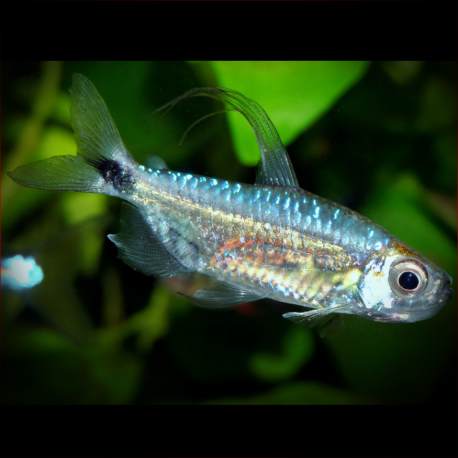More info
Datasheet
| Minimum Tank Size | 160 litres / 42.27 US gallons |
| Maximum Size | 6.0cm / 2.36inches |
| Temperature | 20°C / 68.00°F - 28°C / 82.40°F |
| Hardness | 1.01dgH / 18ppm - 10.03dgH / 179ppm |
| pH | 5.0-7.0 |
General Description
Alestopetersius Smykalai, also known as the Blue Diamond Tetra, is a rare species in the aquarium trade and potentially threatened in its natural habitat. It can be distinguished by characteristics such as the absence of extended median caudal-fin rays in adult males and a dark diamond-shaped marking on the caudal peduncle. Belonging to the Characiformes order, this species is part of the Alestidae family, which is the most speciose among African characiform families.
Aquarium Setup
When setting up an aquarium for A. Smykalai, it is crucial to mimic its natural habitat, resembling a flowing stream or river. The tank should ideally have a substrate of rocks, sand, fine gravel, and water-worn boulders. Driftwood, roots, and branches can be added for shelter, ensuring there is ample open swimming space. To maintain the well-being of this species, regular water changes of 20-30% are necessary, as they are sensitive to fluctuating organic waste.
Behaviour
The Blue Diamond Tetra is a lively and somewhat skittish species that tends to be peaceful, making it suitable for a community aquarium. When housed with similarly sized cyprinids, alestids, cichlids, catfish, or loaches, this fish thrives. In groups of 8-10 individuals, including both males and females, they exhibit interesting interactions, especially when competing for female attention or hierarchical position within the group.
Feeding and Diet
In the wild, A. Smykalai forages on small insects, crustaceans, and fallen fruit. In captivity, they readily accept a diet of small live and frozen foods such as bloodworms, Daphnia, and Artemia. A varied diet that also includes high-quality dried flakes and granules is essential for maintaining their optimal condition and vibrant colors.
Reproduction & Dimorphism
Breeding A. Smykalai in captivity involves maintaining a group of adults in a separate aquarium with an artificial trap to collect their eggs. Once hatched, the fry are large enough to consume Artemia nauplii. Adult males tend to be more colorful, larger in size, and develop highly extended fins compared to females, who have only slightly extended dorsal fins.
Habitat and Distribution
The Blue Diamond Tetra is native to the Imo and Niger drainages in Nigeria, residing in areas resembling streams and rivers. However, due to habitat loss and degradation in Nigeria, particularly in the Niger Delta region, this species is categorized as "Vulnerable" by the IUCN. Nigeria's extensive deforestation and construction of hydroelectric dams have significantly impacted the natural habitats of A. Smykalai.

